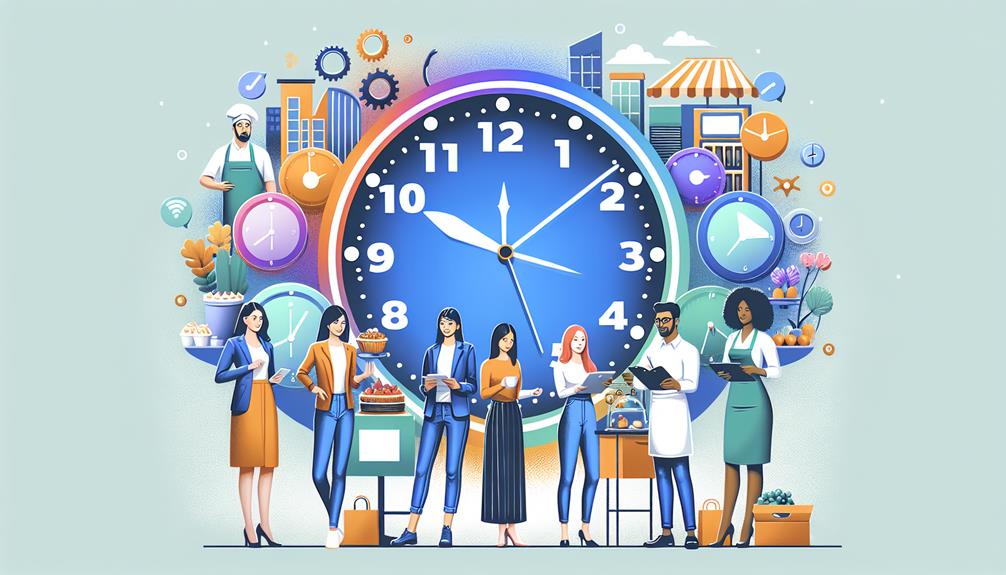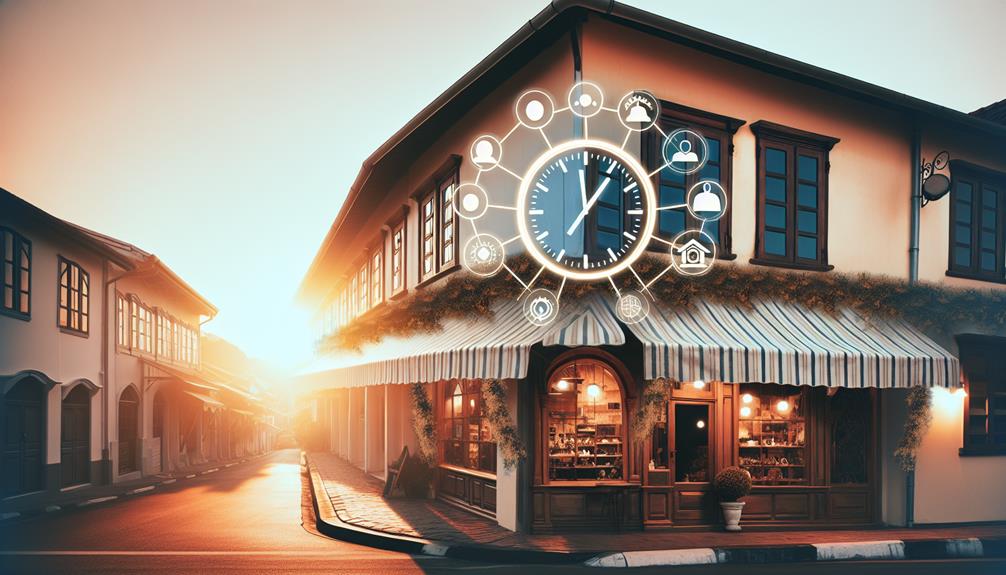

In the realm of social media promotion, the timing of your posts can significantly impact your local business’s online engagement levels. This article will delve into the optimal posting times on various platforms, a critical factor known to enhance audience interaction significantly. The importance of synchronizing content release with your audience’s habits and activity times might be the key to unlocking the full potential of your social media strategy.
By the end of this discussion, you should gain a comprehensive understanding and useful techniques to amplify your business’s online presence.
For instance, consider a local bakery that uses social media to promote daily specials. The best time to post would be in the morning when people are planning their day and looking for breakfast or lunch options. If the bakery posts their specials too late in the day, they miss the opportunity to attract customers who have already made their meal plans. Hence, understanding and implementing optimal post timings can significantly boost the bakery’s visibility and customer[3] base. This real-life example, put in simple terms, underscores the importance of strategic timing in social media marketing.
Additionally, we’ll also explore the nuances of various social media platforms, and how each of them might require different approaches. This knowledge can help you tailor your strategy, ensuring that your content reaches the maximum number of potential customers at the right time, thereby enhancing your business’s online visibility.

Local enterprises, such as Tom’s Coffee Shop or Maria’s Boutique, thrive by comprehending patron conduct. This comprehension necessitates an in-depth dissection of demographic data, preferences, and actions, aiming to tailor messages like a seasoned tailor fits a suit.
Uncovering key data about interests and habits via a strategic demographic investigation can make the difference between a message that flores and a message lost in the void. Furthermore, understanding the favored social platforms and gadgets of their audience is critical for businesses, potentially serving as a catalyst for engagement like a spark ignites a flame.
Factoring in geographical factors such as time zones and location is also a crucial move, ensuring content delivery when the audience is most receptive. Random fact: The most popular time to post on Instagram[4] is between 9 AM and 11 AM EST.
Hence, local businesses like Lou’s Pizza Place or The Green Garden Florists must adopt a meticulous and inventive strategy to comprehend their audience’s behavior, using this knowledge to target specific regions with pertinent content at the most beneficial times.
For local enterprises like ‘Joe’s Coffee Shop’ or ‘Sarah’s Boutique’ to effectively leverage Instagram, key timing is crucial. Peak interaction with followers happens between 6 PM – 9 PM, an ideal slot for dinner specials or evening promotions. Midday hours, 12 PM – 3 PM, and late afternoon, 3 PM – 6 PM, also see heightened engagement, perfect for lunch deals or after-work offers. Strikingly, Saturday is a high-performing day, while Monday trails behind.
Avoid early mornings, specifically the 6 – 9 AM and 9 – 12 AM slots. These hours see minimal interaction, thus, content posted may not reach its full potential. Instagram’s analytics tool, ‘Instagram Insights,’ can be a powerful ally in understanding user behavior and preferences, aiding in the crafting of an effective posting strategy.
A fun fact? Tailored content, one that reflects local offerings, can drastically boost interaction within these optimal time frames. In essence, comprehending Instagram’s unique rhythm and audience interaction patterns is a crucial step towards maximizing visibility and engagement for local businesses.

An effective Facebook posting schedule for local businesses is typically between 10 AM and 12 PM on weekdays. This time frame, known as peak activity time, increases the probability of content reaching its target audience when they’re most engaged.
However, audience behavior isn’t a constant – it fluctuates based on factors such as industry and demographics. For instance, public agencies and charitable organizations often witness better engagement with early morning posts. It’s advisable to refrain from posting on Sundays due to lower engagement levels.
To maximize Twitter engagement for your local enterprise, such as “Jane’s Coffee Shop,” focus on optimal posting times and days. The powerhouse of user engagement lies in the intervals of 9 AM – 12 PM, 12 PM – 3 PM, and 3 PM – 6 PM, with Mondays and Wednesdays being particularly potent days.
| Optimal Days | Prime Engagement Hours |
|---|---|
| Mondays | 9 AM – 12 PM |
| Wednesdays | 12 PM – 3 PM |
For increased visibility, steer clear of early morning posts, specifically between the hours of 6 – 9 AM. Local follower engagement during these peak times can enhance interaction and boost your brand’s online presence.
Here’s a useful fact: Twitter analytics can provide valuable insights into audience behavior, allowing you to tweak your posting schedule for maximum impact. Use this powerful tool to the advantage of your enterprise, whether it’s a neighborhood bakery or a bustling bike repair shop.

Local businesses can amplify their presence by harnessing LinkedIn, a professional networking site with a global membership exceeding 774 million users. Exploiting LinkedIn’s targeted advertising[1] features can enhance a local enterprise’s reach within a specific geographical location.
Here’s how to capitalize on LinkedIn:
Did you know? LinkedIn is available in 24 languages and over 200 countries. It’s a powerful platform that bridges geographical divides and connects professionals worldwide.
FAQs
1. What are audience engagement patterns?
Audience engagement patterns refer to the times and ways in which your audience interacts with your content. These patterns can include likes, shares, comments, and other forms of engagement.
2. How do platform algorithms affect post timing?
Platform algorithms affect post timing by prioritizing content that generates engagement. Posting at times when your audience is most active can increase the likelihood of engagement and visibility.
3. What is meant by peak hours in social media posting?
Peak hours refer to the specific times when your audience is most active on social media. These hours can vary depending on the audience’s demographic and lifestyle factors.
4. How do global audiences’ time zones impact post timing?
Global audiences’ time zones impact post timing as it determines when your content is most likely to be seen. Businesses with a global reach often schedule posts according to the peak activity times of their target audiences in various time zones.
5. What are analytics tools in the context of social media?
Analytics tools are software applications that measure and analyze data related to social media usage. They help businesses understand their audience behavior, engagement rates, and optimal posting times.
6. Why is consistent posting during high-engagement times important?
Consistent posting during high-engagement times maximizes the visibility and reach of your content. It ensures that your posts are seen by a larger segment of your audience, potentially increasing engagement and interaction.
7. How can I determine the high-engagement times for my audience?
High-engagement times can be determined through analytics tools that track when your audience is most active. Regular analysis of this data can help pinpoint the most effective times to post.
8. How does the type of content affect engagement?
The type of content can significantly affect engagement. Posts that are visually appealing, informative, and relevant to your audience are more likely to generate likes, comments, and shares.
9. What is the role of audience demographic in post timing?
Audience demographic plays a significant role in post timing as different age groups and professions have varying social media habits. Understanding your audience’s demographic can help tailor your post timing for maximum engagement.
10. How often should a business post on social media?
The frequency of posts depends on the platform and the audience’s engagement patterns. However, consistency is key, and businesses should aim to maintain a regular posting schedule.
What does content consistency in a posting schedule mean?
Content consistency refers to the regular and systematic publishing of posts, ensuring a steady flow of fresh content to engage the audience.
How does audience engagement factor into a posting schedule?
Audience engagement determines the best time to post, as it involves analyzing when the audience is most active and responsive, thereby maximizing visibility and interaction.
What is meant by posting frequency in a posting schedule?
Posting frequency refers to how often you publish content on your platforms, which should be balanced to keep the audience interested without overwhelming them with too much information.
How do peak activity times impact a posting schedule?
Peak activity times are when the majority of your audience is online. Posting during these times increases the chances of your content being seen and interacted with.
What is a strategic timing approach in a posting schedule?
A strategic timing approach involves planning your posts around specific events, trends, or times of day to maximize audience engagement and relevance.
How does seasonal posting influence a posting schedule?
Seasonal posting refers to tailoring content around specific seasons, holidays, or events, which can increase its relevancy and appeal to the audience.
What are platform specifics in a posting schedule?
Platform specifics refer to understanding the unique characteristics of each social media platform, such as optimal post lengths and formats, to optimize your posts for each platform.
Why are time zone adjustments necessary in a posting schedule?
Time zone adjustments ensure that your content reaches your audience at the most appropriate times, especially if your audience is spread across different geographical locations.
What are content gaps in a posting schedule?
Content gaps are topics or areas that your content has not covered yet. Identifying these can help diversify your content and cater to a wider range of audience interests.
FAQ Section:
1. What are the best days for small businesses to post on Facebook?
Small businesses often find the most engagement on Facebook from Monday to Thursday, with Tuesday showing the most interaction. However, this may vary depending on the specific audience and industry of the small business.
2. What time should retail businesses post on Facebook for maximum engagement?
Retail businesses often see high levels of engagement on Facebook posts around 10 a.m. This can change depending on the shopping habits of the target audience and specific industry trends.
3. Does the optimal posting time change for businesses in different industries?
Yes, the optimal posting time on Facebook can vary depending on the industry. Each industry has unique audience behaviors, which can influence when posts receive the most engagement.
4. Is there a difference in engagement levels on Facebook between weekdays and weekends?
There is usually a decrease in Facebook engagement over the weekend. However, this trend can change based on the audience’s lifestyle and habits.
5. How does the performance of a Facebook post change throughout the day?
The performance of a Facebook post can vary throughout the day. It often peaks around 10 a.m., but this can change based on the daily routines and online behavior of the target audience.
6. Are there specific days when businesses should avoid posting on Facebook?
While there’s no specific day to completely avoid, businesses tend to see less interaction over the weekend, particularly on Sundays. This can vary based on the audience’s online activity during the weekend.
7. What is the ideal frequency of posts for businesses on Facebook?
The ideal frequency for businesses to post on Facebook depends on their specific audience engagement. However, consistency and quality of content should always be prioritized over quantity.
8. How does the engagement of a Facebook post change during peak and off-peak times?
During peak times, Facebook posts often see higher engagement, while posts during off-peak times may receive less interaction. This fluctuation is influenced by the audience’s online activity patterns.
9. Can businesses expect consistent engagement on Facebook posts at 10 a.m.?
While 10 a.m. is generally a high-engagement time, businesses may not always see consistent engagement at this time every day. This is influenced by various factors such as audience behavior and relevant events.
10. What factors can influence the best time for a business to post on Facebook?
Factors that influence the best time to post on Facebook include the target audience’s online activity, industry-specific trends, and the day of the week. These factors should be considered alongside the business’s goals and content strategy.
